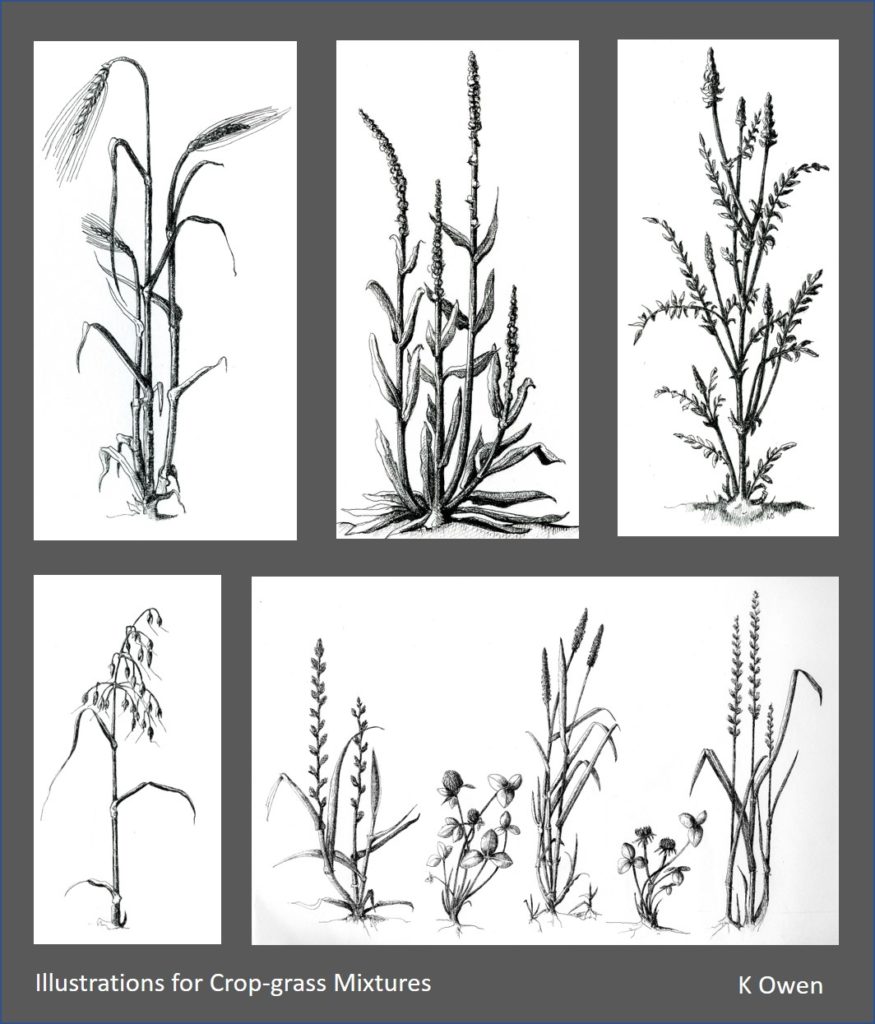
Illustrating crop-grass mixtures

sustainable croplands

What a name! A practical guide to ‘grass’ seed mixtures and other fodder crops in various editions in the 1800s by the Lawsons, Edinburgh seed merchants. Examples of complex grass mixtures, where ‘grass’ included legumes and other broadleaf species. Legumes typically 25% by weight of seed. Sometimes sown with a corn, such as barley, to protect the grass in the first year. Guidance on fodder crops such as sainfoin and whin (gorse). High sown diversity, now mostly gone, but recorded. Latest in the Living Field’s series on crop diversification.
The Living Field’s exploration of crop diversification or re-diversification – growing more things and more different things on the same piece of land – found that some complex species mixtures used in the 1800s and early 1900s had reformed in the Garden’s meadow and surrounding grass [1]. Some species were sown but others just moved in, presumably enticed by the low-nutrient status of the soil and some friendly neighbours.
A century or more ago, grass seed mixtures were varied to suit the intended use. So, for example, those for one crop of hay had fewer species than others for permanent pasture. Yet what is clear from Agrostographia [2] and later works [3] is that quality ‘grass’ seed in the 1700s and 1800s consisted of complex mixtures of grass, legumes and other broadleaf (dicot) plants. On many farms, the forage legumes probably contributed more of the overall nitrogen input by biological fixation than crops such as beans and peas. The legumes also had a higher and different protein content to that of the grass species.
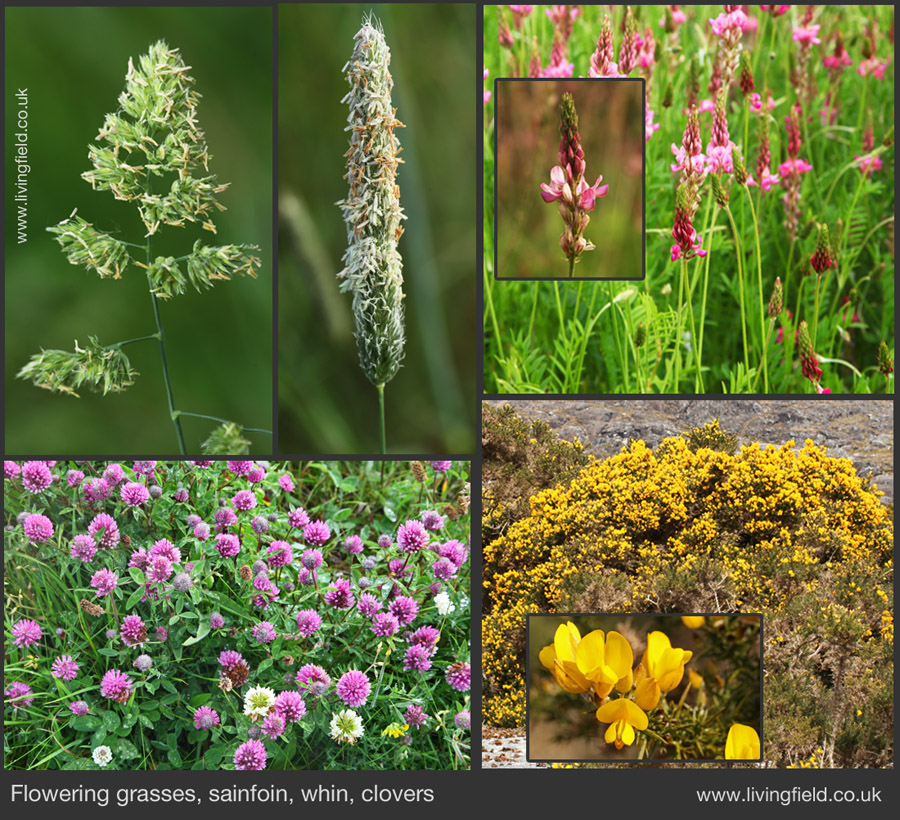
Given present interest in re-diversification, we here explore this practical guide and definitive study of complex ‘grass’ seed mixtures and other fodder crops.
The 1800s was a time of great invention and experimentation. The Improvements of the 1700s had shifted agriculture to a higher trajectory, but there was still a need to improve the ‘grass’ that cows and sheep grazed and were fed. The process of nitrogen fixation by legumes was not scientifically understood, but the experimenters knew that legumes like clovers enriched the soil and gave better yields of livestock when they were present as part of the ‘grass’.
Among the foremost experimenters of the time, from the early 1800s, were the Lawsons, a seed company based in Edinburgh. In addition to their major efforts in trialling and documenting all the arable and horticultural plants that were and could be grown in Scotland [4], they were active in experimenting on ‘grass’ seed mixtures for different purposes.
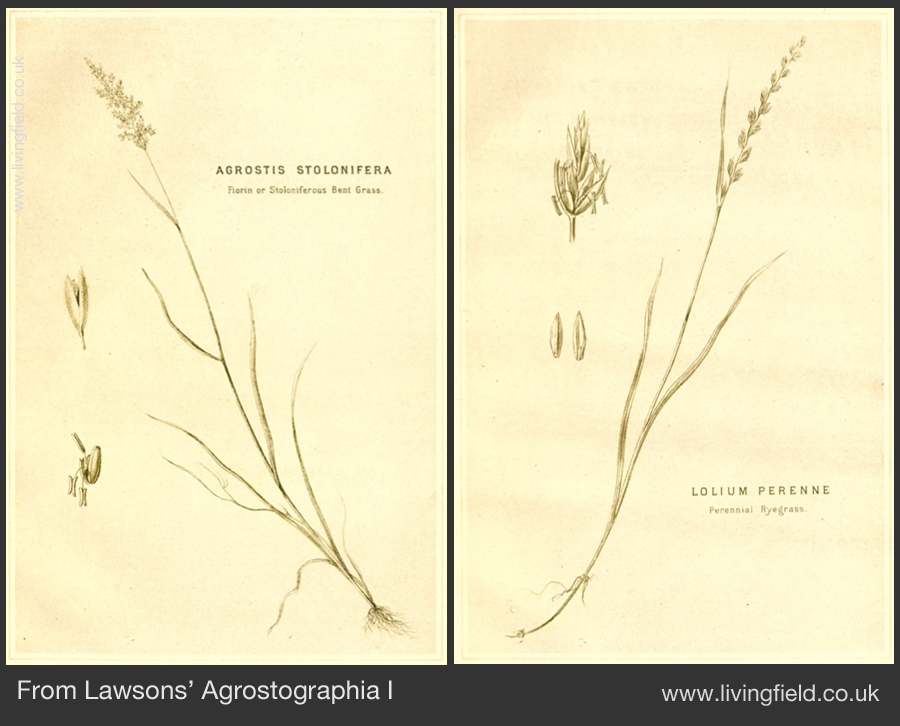
They worked on trials first in the early 1800s, published their recommendations in 1833, refined them in their 1836 Agriculturalist’s Manual [4], and continued to update them in editions of the treatise named Agrostographia [2], the 6th edition of 1877 being used here. The treatise contains an introduction to grass mixtures, then tables which advise the species and weights of seed that should be sown for different purposes, such as long-term grazing, pasture under orchard trees, conversion of wet land and stabilising soil against coastal erosion.
The refinement and complexity of these seed mixtures was a way forward – a way out of the stagnation of unimproved grazing land.
Where the aim was for one to three years hay or pasture, Agrostographia recommends mixtures of 6 – 9 species of grasses and legume, usually those able to form cover quickly. Mixtures for permanent pasture were more complex, selected from 16 types of grass and 7 types of legume (Fig. 1), where ‘types’ were mostly different species but occasionally different varieties of a species. The mixtures were varied slightly to suit three grades of heaviness of the soil and depending on whether the grass seed mixture was sown along with a corn crop, such as barley in spring, to ‘nurse’ the grass mix until it established. The corn was then usually cut along with the grass for a first hay.
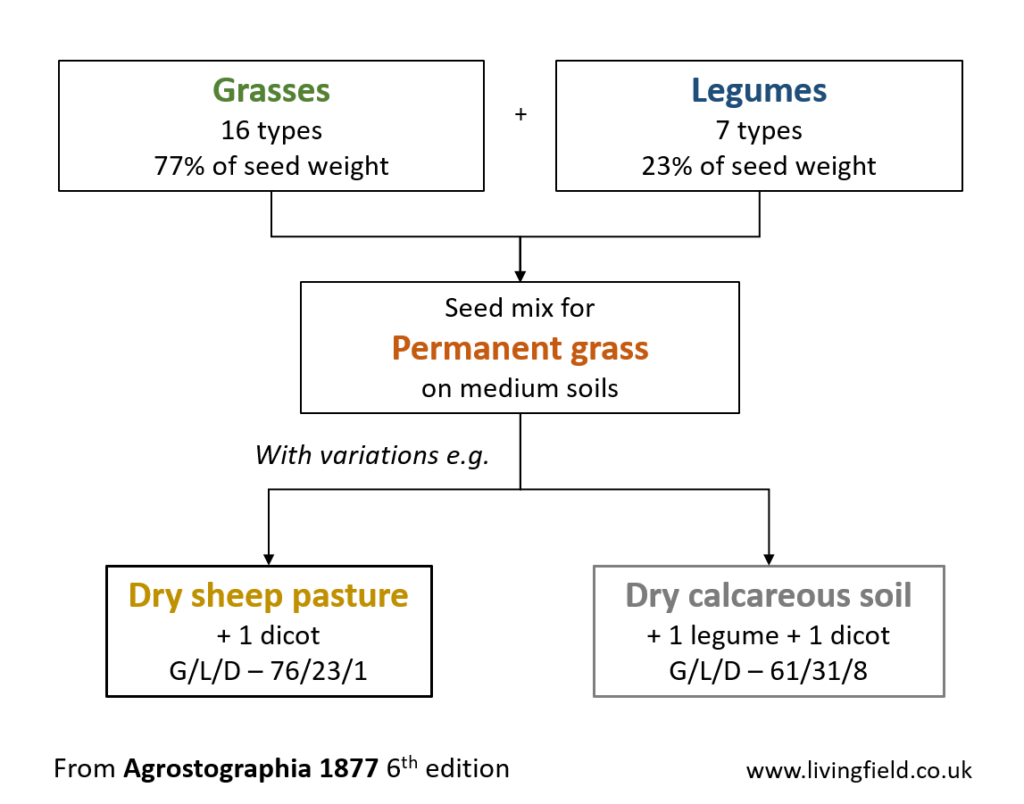
Fig. 1 Composition of grass seed derived from 16 grass and 7 legume types (mostly different species) for permanent pasture, the % seed weight in the top two boxes for medium soils with a ‘nurse’ corn crop sown at the same time. Variations below show the grass/legume/dicot (G/L/D) proportions after additional seed was included for specific purposes. From Table III for permanent pasture mix No. 2 in Agrostographia 1877.
Legumes typically made up 20-25% of the standard seed weight in permanent pasture mixes. The proportion of legumes rose to more than 30% both in grass intended for one to three years duration and for permanent pasture in some conditions such as dry calcareous soil, where sainfoin was recommended along with standard legumes (Fig. 1).
The mixes present a marked contrast with most grass fields today, which contain no legumes or at best a sprinkling of white clover.
Across their various mixtures, the Lawsons tested and gathered seed for about 50 species of grasses, legumes and other dicot plants. They treated each one like a separate crop, whose traits were identified, and which should contribute specific properties to a mix. The mixes achieved a spread of flowering and maturity times and a balance of architecture and feeding quality in the sward [3].
The most abundant grass species in pasture mixes were perennial and italian ryegrass, but others included cock’s-foot, timothy, foxtail and several species each of fescues and meadow grasses. The most abundant legumes were white clover and red clover, the latter often in its perennial form, while others included bird’s-foot trefoils, medics and occasionally sainfoin.
The annular diagram (Fig. 2) shows for a specific mix the proportion of each species or variety in the outer circle in the order given in the manual. Colours and shades of grass from blue to green and legumes from red to pink are to help differentiate the types. The lesser species were each present at between 2% and 6% of the total weight.
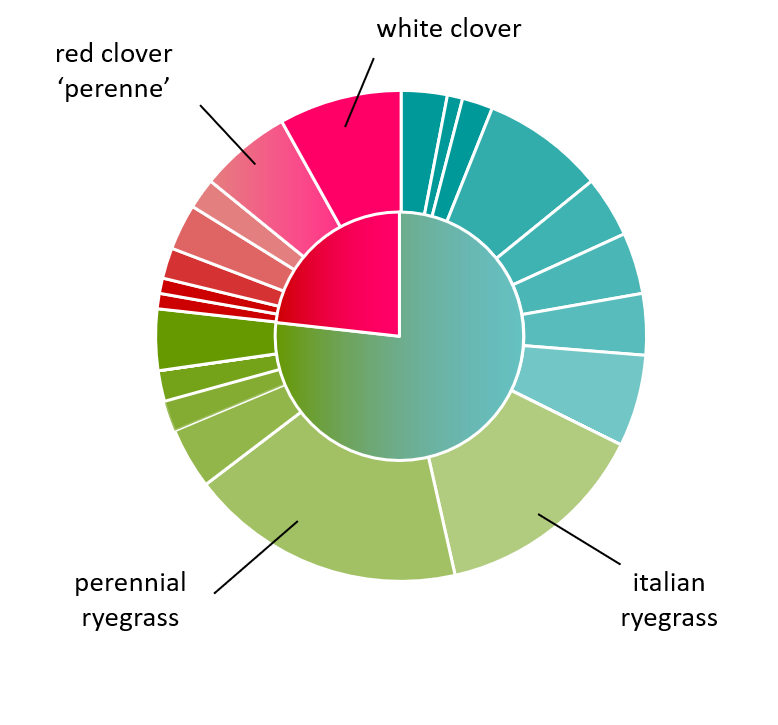
Fig. 2 Proportions of species or varieties of grass (blue, green) and legumes (red, pink) in a seed mixture for permanent grass on medium soils assuming sown with a corn crop. From Table III for permanent pasture mix No. 2 in Agrostographia 1877 .
Judging by the many editions and reprints, the Lawsons’ Agrostographia must have influenced many progressive farmers in their attempts to improve hay and grazing. Its contribution was recognised by agriculturalists like Preston, writing in 1887 [5].
The authors distinguish members of the grass family by grouping all legumes and other broadleaf or dicot plants as ‘artificial’ grasses. Among these artificials were typical forage legumes such as lucerne, sainfoin and various tares (e.g. Vicia sativa), which were sometimes grown as a single-species crop, and also plantains, burnets, and yarrow.
Sainfoin and lucerne were at that time commonly grown in the south of Britain, much less in the north. The authors state that the climate of Scotland is too cold for lucerne but sainfoin can be grown in ‘dry’ soils with help in the first year from a nurse corn.
Whin or gorse was another nitrogen-fixing legume recommended as a crop to be cut and pulped for cattle or eaten directly by sheep in the first year or two of growth. Today large areas of rough grazing land are covered by whin, which appears to be rarely eaten by livestock, but Agrostographia recommends growing it from seed in a field as a fodder crop.
Scotland and indeed much of the UK got all its major crops from other parts of the world. The main cereals came from east of the Mediterranean, potato from across the Atlantic and forest plantation trees, such as sitka spruce, from north America. Even many of our weeds were imported or found their way here.
The position is more complicated for grassland. Traditional, species-rich hay meadows are very rare, around 3% now remaining of those present in Britain before the post-war phase of agricultural expansion. The latest issue of Plant Life magazine points to the botanical richness of the Muker meadows in Yorkshire, for example [6].
Where then do Agrostographia‘s seed mixtures lie on a scale of diversity between such traditional hay meadows and today’s fertilised ryegrass? The combination of more than 20 species takes them far ahead in terms of botanical diversity than nearly all commercial grass fields today. That botanical diversity would have stimulated microbial and invertebrate diversity and hence food for birds and mammals.
They are however less diverse than ancient hay meadows. The mixtures were intended as a crop, a means to increase production measured in the the growth in weight of sheep and cattle per unit area of land. It was before mineral fertiliser was widely used; hence the essential presence of legumes. The capacity of ryegrass for high yield was appreciated. It’s as if the move to ryegrass species, including imported forms, began at this time, well before they came to dominate managed grazing land after the 1950s when mineral fertiliser was routinely applied.
Moreover, Agrostographia’s seed mixes did not consist of just native or local species and varieties. More productive forms of local species were imported and trialled. In describing red clover Trifolium pratense, the authors refer to a common type named English Red Clover, but are aware of a range of other forms named German, Dutch, Flemish, French, American and Normandy. Which of these were use in the various seed mixtures is unclear. Similarly, some improved types of the major grasses were imported from north America.
Agrostographia’s seed mixes are perhaps best viewed as a crop, but one bringing very high in-field biodiversity compared to almost anything else grown at that time.
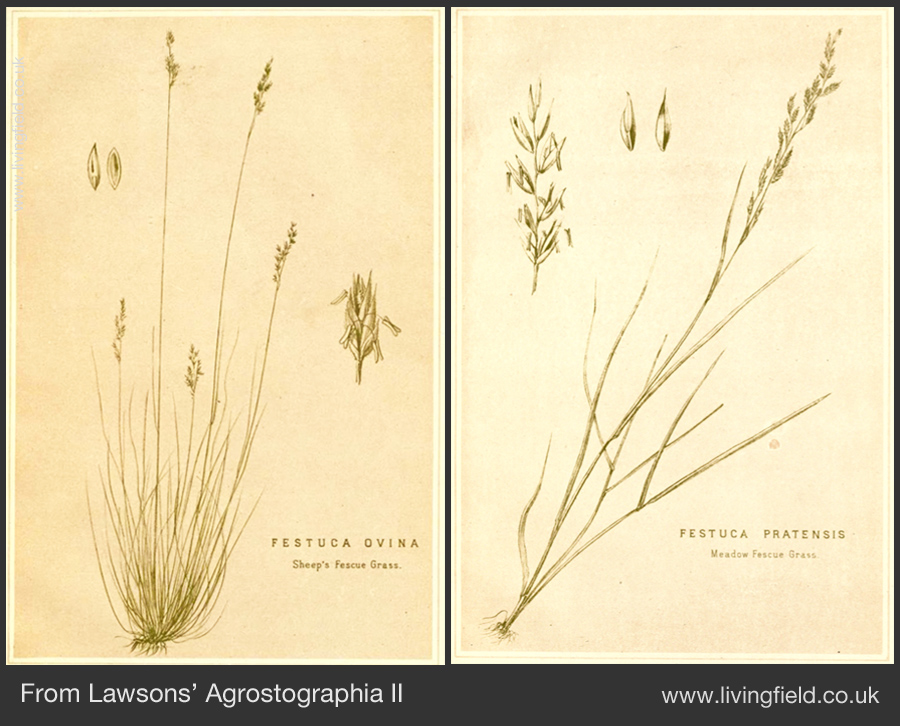
The seed mixes recommended in Agrostographia [2] and related works [3] from the 1800s and early 1900s are a lesson on what can be done to achieve higher production by combining plants having different functional properties. Compared to today’s low-diversity grass they would produce low greenhouse gas emissions, conserve and build soil, and support a rich and active food web.
They could be guides or templates for re-diversification. The mixes could be adapted for different soils and were clearly successful, being used for a large part of the 1800s and later [5]. Several questions remain about them. They probably consisted of imported and native forms. And it is not known whether any of permanent pasture sown in the 1800s remains today – there have been no surveys, and it is even unclear how many fields of permanent grass today contain even one legume. Managed grass is perhaps the most under-surveyed form of agricultural vegetation in Scotland.
The single most valuable lesson from these pioneering works on grassland [2, 3] is that the soils and climate of the country can support complex grass seed mixtures. There is nothing to prevent their revival. Things have changed in the past century but not enough to invalidate their mixtures as starters for trials and experimentation.
Crucial to their adoption in the present time is how they are to be assessed. Rather than being judged on just one output – mass of livestock per unit area – grassland should be judged on a range of other vital criteria including GHG emissions, soil building and support of the food web. If that were the case then complex grass-legume mixtures would win.
[1] For previous Living Field posts on diversification of crops and grass: Diverse grass mixtures in the Living Field meadow and Crop diversification; on a related site, see Grass mix diversity a century past.
[2] Agrostographia; a treatise on the cultivated grasses and other herbage and forage plants. Authors: The Lawson Seed and Nursery Company. Successors to Peter Lawson and Son. Date: 1877 (6th Edition, by David Syme, Manager). Publisher: William Blackwood & Sons, Edinburgh and London. Online through sources such as the Biodiversity Heritage Library. [Agrostographia as a title is of much older origin, being that of a major compendium on grasses written in Latin, by or edited by, Johannes Scheuchzer (1684-1738), published 1719, edition of 1775 viewed. Did the Lawsons borrow the name ?]
[3] Other examples of seed mixtures used in the 1800s and early 1900s are given books and manuals by authors H Stephens (1841), RH Elliott (1898, 1908), and WM Findlay 1925. Full details and links on the curvedflatlands site at Grass mix diversity a century past.
[4] Peter Lawson and Son’s main other works are the Agriculturist’s Manual (1836) and the more comprehensive Synopsis of the Vegetable Products of Scotland (1852), available online for download, details and links on this site at Bere in Lawson’s synopsis.
[5] Preston, Samuel P. 1887. Pasture grasses and forage plants, and their seeds, weeds and parasites. Publisher: TC Jack, Ludgate Hill, London. Available online for download.
[6] McCarthy, M. 2020. Fields of gold. Plant Life 86, 28-29 (Spring 2020) – on the Muker meadows in Yorkshire.
[Last edited: 28 April 2020 with minor amendments]
Mixtures sown for hay or grazing in the 1800s. Grass, legumes and other broadleaf plants selected for their ablity to live together. Many of the plants grown then coexisting now in the Living Field garden. Lessons for grass rediversification today. One of a series of articles on crop-grass diversification.
The run of bad weather, crop failure and hunger of the late 1600s, sometimes called ‘the ill years’, was one of the factors that led to a period of agricultural improvement from the early 1700s to the late 1800s. The improvements raised and to a degree stabilised food production. One of the most important developments was the design and trialling of species-rich plant mixtures for hay and grazing.
Early accounts of ‘grass’ mixtures by agriculturalists, notably Stephens, Elliot and Findlay, are valuable to us today because they gave weights of the seed of each plant species that made up the mix [1]. Though weight of sown seed does not translate directly into mass of the species in the field, it is the only measure handed down to us by which the diversity of those old mixes can be quantified and compared with today’s commercial seed mixtures.
Why is this important? Over the last 150 years, crop-grass agriculture has become less diverse, more dominated by a few grass species and in the process losing many ecological functions. Plans to re-diversify could learn from past practice.
The hay and grazing mixtures from this period are summarised in a related web article [1] as circular diagrams, the inner ring showing the proportions of grass (blue-green), nitrogen-fixing legume (red) and, when included, other broadleaf plants (orange-brown), while the outer ring shows the proportions of individual species. The diagrams below show the rise in complexity of the mixtures from one-year-hay (1) to two-year grazing (2) and permanent pasture (3, 4).
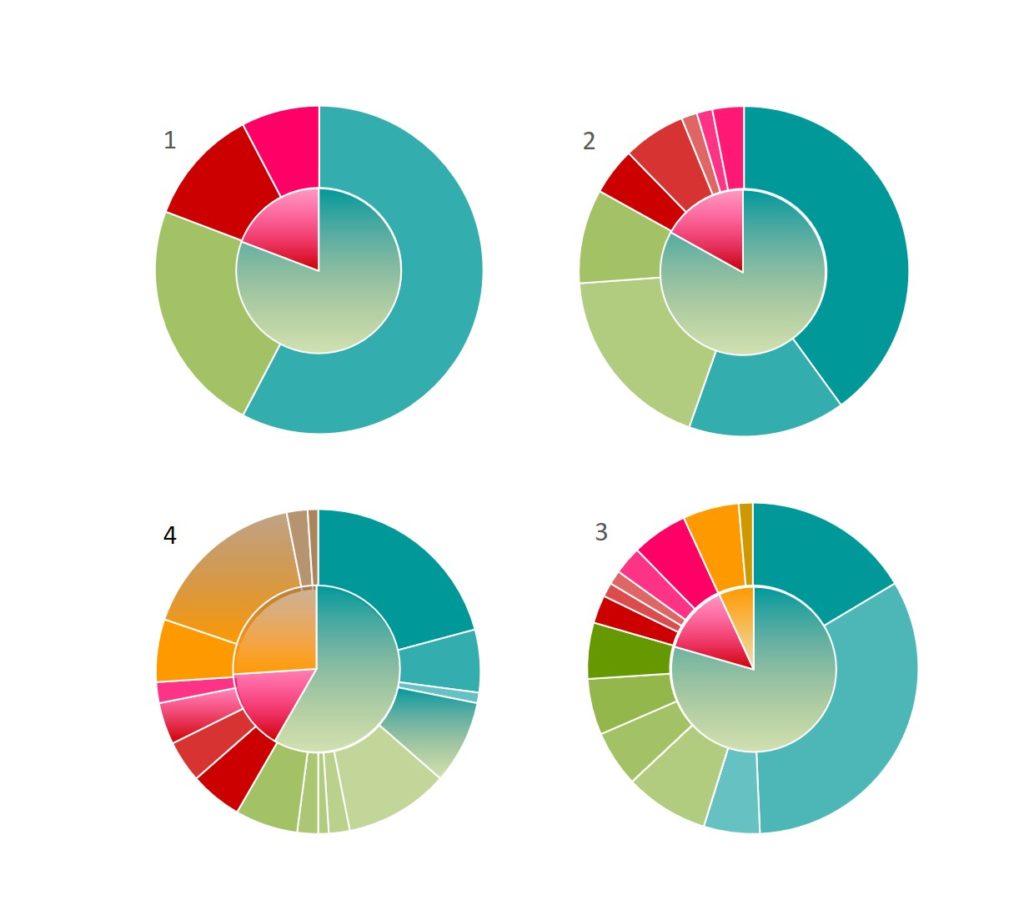
The main feature of those mixes – though rarely seen today in commercial grass fields – is the presence of several legumes species and sometimes broadleaf plants other than legumes. The role of the legumes is to fix nitrogen gas from the air and so enrich the soil for the grass species at a time when mineral fertiliser was not widely available. The other broadleaf species were included to fill ecological gaps (functions and processes) that could not be provided by the grasses or legumes.
The meadow in the Living Field garden [2] was sown back in 2004. In the first few years, the most visible plants were those that grew quickly and flowered in the first or second year. These annuals and biennials were soon ousted by perennials, some that had been sown and others that came in. After 5 or 6 years the meadow was populated by a diverse group of perennials.
The meadow has been lightly managed – cut once a year, usually in September. Yet many of the plant species that were part of the 1800s mixtures appear naturally able to coexist in the meadow and surrounding patches.
The typical legumes in early grass mixtures were clovers, the red and white species but also alsike and several others. Red Trifolium pratense was thought best for one year’s hay because it was fast growing but short lived, while white Trifolium repens persisted much longer and was suited to pasture. Both have lived in the meadow for at least a decade. Alsike Trifolium hybridum was grown as part of a legume collection a few years ago but has not remained.
Other legumes in sown mixtures from the 1800s included the bird’s-foot trefoils, mainly Lotus corniculatus which is as common in the meadow as white clover, and kidney vetch Anthyllis vulneraria which persists as only a few plants here and there among the grasses and sometimes in the medicinals bed.
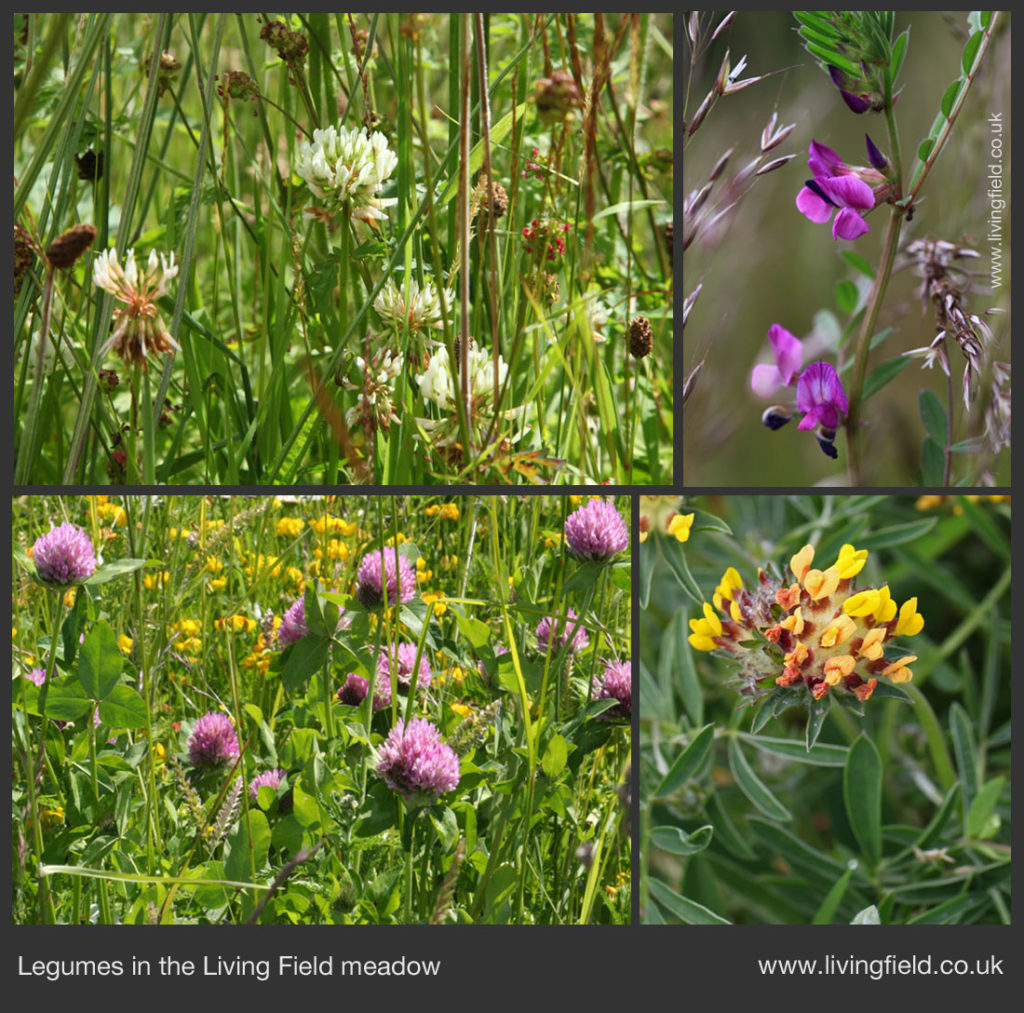
The meadow has other legume species, of the genus Vicia, that were not generally favoured in earlier mixtures because they have tendrils and so tend to twine among and drag down the grasses and other plants.
Two common tendril-bearing species recur in the meadow each year – common vetch Vicia sativa which generally keeps to itself and hairy tare Vicia hirsuta which can become a serious weed (as this year) smothering other plants. A third one of this type, tufted vetch Vicia cracca tends to move around unkempt patches rather than live in the meadow.
The images in the legume panel above show (top left, clockwise) white clover among grass and plantain, common vetch, kidney vetch and red clover with bird’s-foot trefoil (yellow flowers).
It may come as a surprise today to learn that plants other than grasses and legumes were purposely sown in fields as part of mixtures for hay and pasture. Of those reported from the 1700s and 1800s, the commonest in the meadow itself are yarrow Achillea millefolium and ribwort plantain Plantago lanceolata.
Two others have appeared in grassy areas – chicory and burnet. Chicory Cichorium intybus was first planted in the medicinals bed, but has spread and now lives among grasses such as yorkshire fog and cocksfoot. Its main role in the 1800s mixtures was to break through soil pans that formed at 10-20 cm depth due to the shallow ploughing that was typical of the time.
A few plants of burnet Sanguisorba minor were noted a some years ago, and like chichory have persisted for years among competitive grass species. We do not know where the burnet came from.
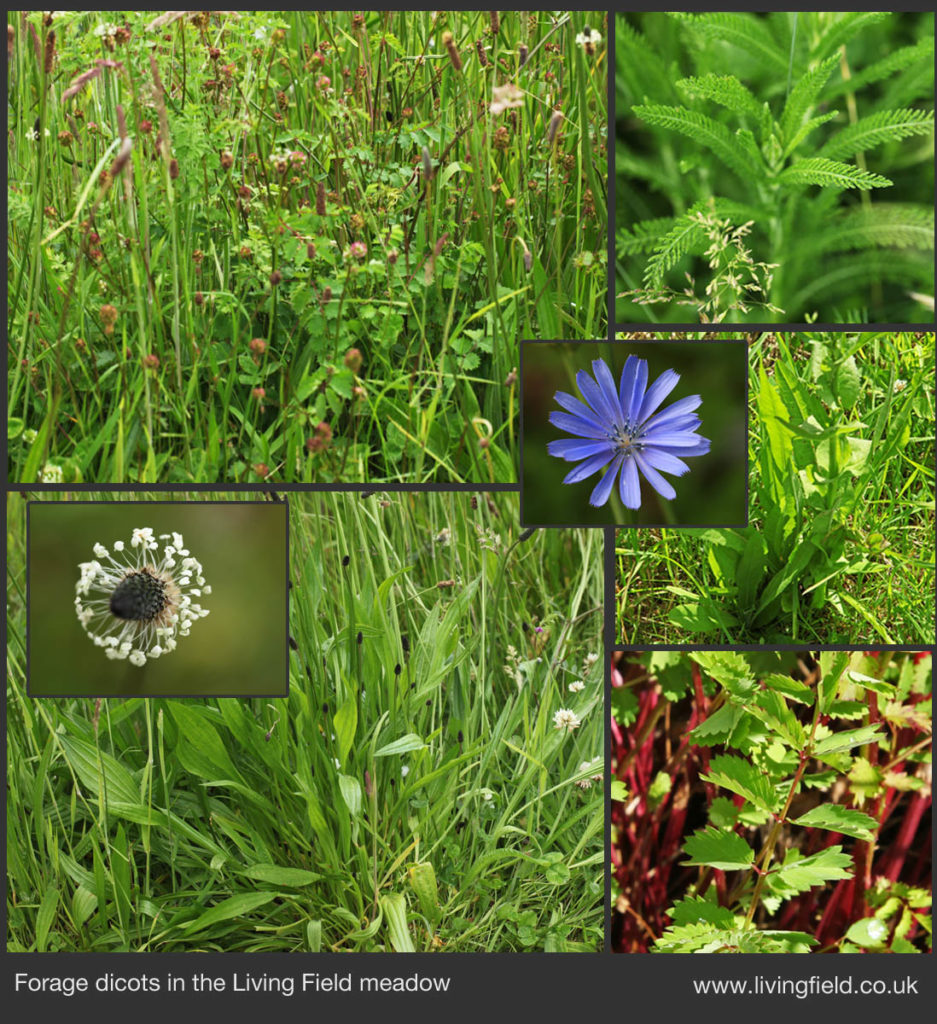
The images above show (top left, c’wise) burnet and ribwort plantain among grasses, yarrow leaf, chicory plant with blue flower inset, burnet leaves and red stems. and finally ribwort plantain with flower inset.
They might ‘all look the same’ in leaf, but their basic floral structure recurs in many forms to give great diversity among our common grass species. Many of the early sown mixtures included timothy-grass Phleum pratense, cocksfoot Dactylis glomerata, crested dog’s-tail Cynosurus cristatus, several fescues (Festuca species) and tall meadow-grasses (Poa species), all of which are present in the meadow.
Two other pasture grasses are common in the garden – sweet vernal-grass Anthoxanthum odoratum and yorkshire fog Holcus lanatus which become established wherever the ground is left untilled for a few years.
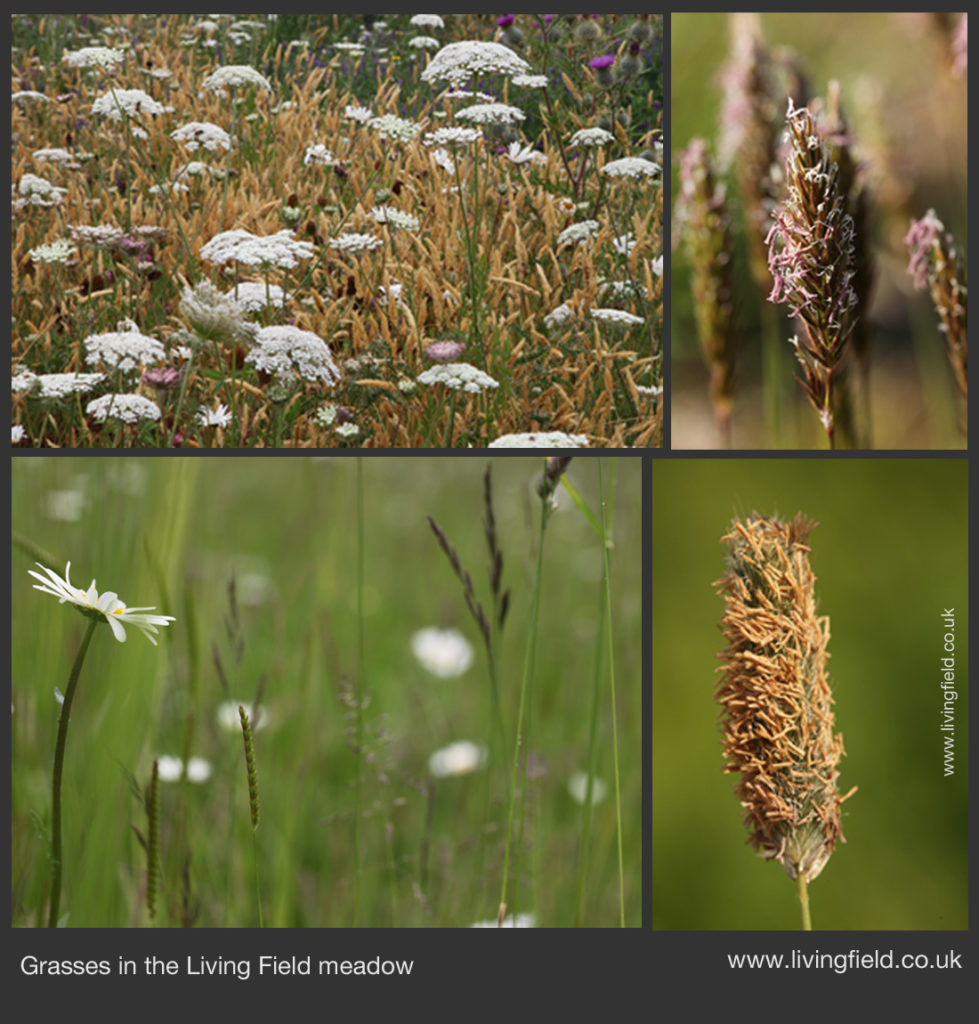
The grass panel above shows (top left, c’wise) mainly yorkshire fog growing among wild carrot, flowering heads of sweet vernal and timothy and (from the early years) fescue and crested dog’s-tail among ox-eye daisy.
The 1800s mixtures were designed to give a balanced diet for livestock and to ensure fresh plant tissue was present for a long as possible during the year. They mixed species to ensure that each came to prime leaf or seed at different times. For hay, the progression of floral or reproductive structures was important, for pasture the blend of leafy parts.
The meadow in the Living Field garden also harbours other plants sown specifically for wildlife, including field scabious, perhaps the favourite of the pollinating insects, ox-eye daisy and lady’s bedstraw. At one time wild carrot lived in the meadow (top left in the grass panel above) but now prefers grassy margins next to paths. Even with these additional species, the meadow complex retains many of the species sown for hay and pasture from the 1700s to the early 1900s.
The secret of sustaining the meadow is to keep soil fertility low by not fertilising and ground cover high by growing many species that quickly react to fill any gaps. No one species dominates and noxious weeds are given little chance to enter.
[1] The original sources, mainly Wight (late 1700s), Stephens (1841 onwards), Elliot (1898 onwards) and Findlay (1925) are given in this companion article: Grass mix diversity a century past on the curvedflatlands web site.
[2] The origin, main species and management of the meadow are described on this web site at Garden/Meadow and Garden/The_making. The drone image below from early 2019 shows the location of the meadow (covering about 200 square metres), see also : Living Field garden from the air.
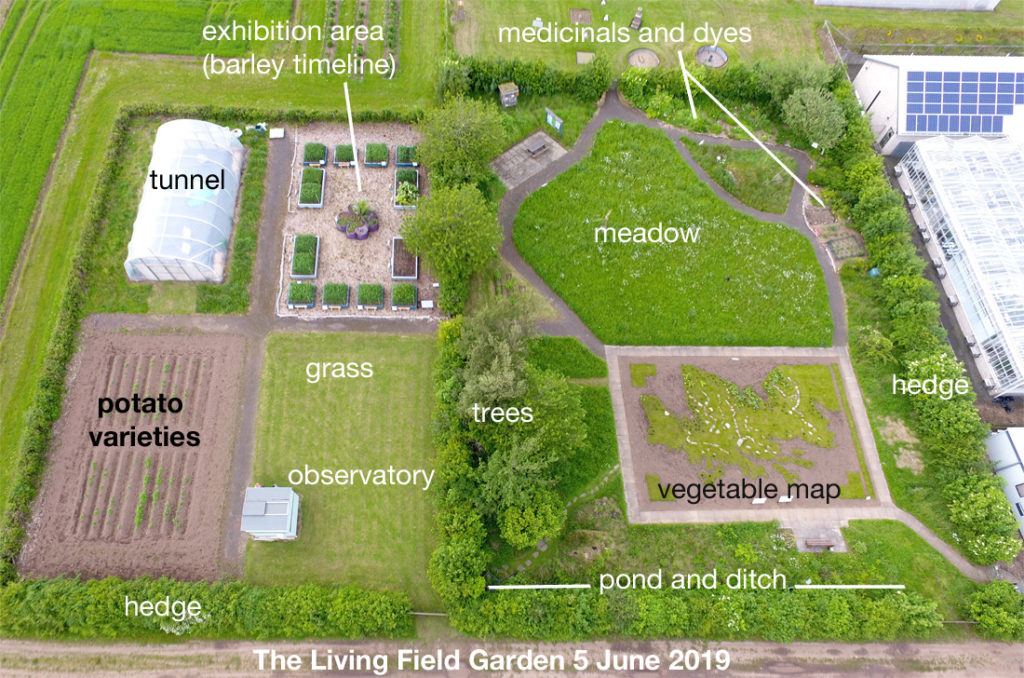
The Living Field team has maintained very high diversity per unit area here for almost 15 years.
Contacts: this article geoff.squire@hutton.ac.uk; meadow management gladys.wright@hutton.ac.uk.